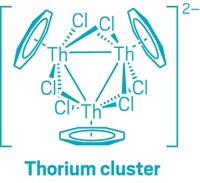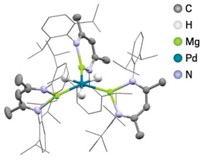Advertisement
Grab your lab coat. Let's get started
Welcome!
Welcome!
Create an account below to get 6 C&EN articles per month, receive newsletters and more - all free.
It seems this is your first time logging in online. Please enter the following information to continue.
As an ACS member you automatically get access to this site. All we need is few more details to create your reading experience.
Not you? Sign in with a different account.
Not you? Sign in with a different account.
ERROR 1
ERROR 1
ERROR 2
ERROR 2
ERROR 2
ERROR 2
ERROR 2
Password and Confirm password must match.
If you have an ACS member number, please enter it here so we can link this account to your membership. (optional)
ERROR 2
ACS values your privacy. By submitting your information, you are gaining access to C&EN and subscribing to our weekly newsletter. We use the information you provide to make your reading experience better, and we will never sell your data to third party members.
Synthesis
Boron-Oxygen Triple Play
Multiple Bonding: First isolable compound with a B≡O bond, thanks to platinum coordination
by Stephen K. Ritter
April 19, 2010
| A version of this story appeared in
Volume 88, Issue 16
By using platinum as a stabilizing influence, a team of inorganic chemists led by Holger Braunschweig of Germany’s University of Würzburg has created just the right set of electronic conditions to achieve one of chemistry’s few remaining bonding feats: creating an isolable compound with a Boron-Oxygen triple bond (Science 2010, 328, 345). Besides being the first metal complex with a boron monoxide ligand, the platinum oxoboryl complex and others like it could be useful as chemical building blocks or in catalysis.
Boron is known for its electron deficiency and its propensity to compensate by participating in multicentered bonds that let it draw electron density from neighboring atoms. But chemists have rarely enticed boron to participate in double or triple bonds.
Lai-Sheng Wang of Brown University and coworkers previously found that fleeting gas-phase species such as Au2B≡O− have a B≡O bond that is as strong as the triple bonds in electronically equivalent CN− and CO complexes. “We wondered why no metal complexes with oxoboryl ligands had been synthesized when CN− and CO are ubiquitous ligands in inorganic chemistry,” Wang says. Braunschweig’s team shows that “the trick appears to be stabilization of B≡O through significant platinum-boron covalent bonding,” he says.
Braunschweig’s group previously showed how a metal center can be used to stabilize the B≡N bond in iminoboryl complexes. Building on that work, Braunschweig, Krzysztof Radacki, and Achim Schneider made the B≡O complex by treating Pt(PR3)2, where R is cyclohexyl, with Br2BOSi(CH3)3 in toluene at room temperature. The resulting intermediate eliminates BrSi(CH3)3, leaving behind B≡O as a novel ligand in (PR3)2BrPtB≡O.
The complex is unusually stable to heat and light, and even when the team treated it with ammonium thiophenylate, the thiophenyl group bypassed the B≡O ligand and opted to exchange with the bromine ligand, forming an oxoboryl thiophenyl complex.
Armin Berndt of Philipps University, in Marburg, Germany, an expert on multiple bonding and aromaticity in boron compounds, says achieving the B≡O bond is like a “Sahnehäubchen”—getting whipped cream “on top of a masterful series of studies on the stabilization of unusual boron species by metal complexation.”






Join the conversation
Contact the reporter
Submit a Letter to the Editor for publication
Engage with us on Twitter